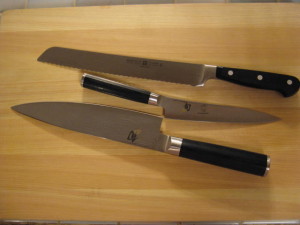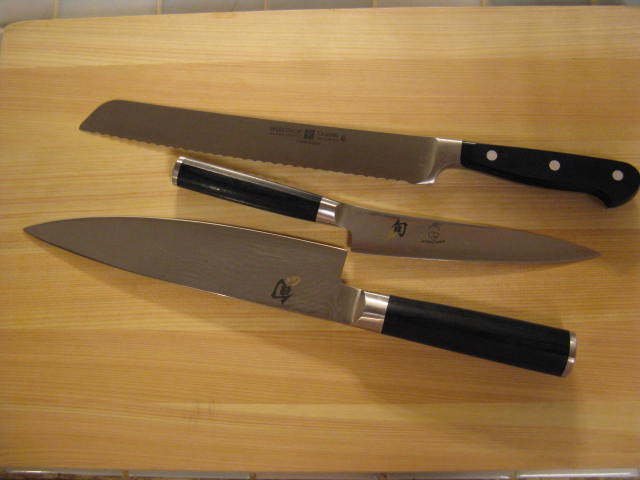Wash and dry your knives immediately after use. You honestly only really need to rinse them off and dry them most of the time. Pretty much all knives are food-service certified, and stainless steel is non-porous so germs can’t “get in”.
- Most of the time I just run warm water and very carefully wash with my fingers, then towel-dry, and this is the recommended method by all knife manufacturers.
Dishwashers – I always say if you love it, don’t put it in the dishwasher. But if you’re going to do it, do NOT lay them flat on the racks–use the plastic flatware basket. If it doesn’t fit, wash it by hand.
- Reason: Your dishwasher shakes; this is part of how it cleans. Things bump each other, and your knife will bump the plastic coating on the prongs repeatedly, cutting them and exposing the metal underneath, and then pretty soon your flatware will all start coming out rusty. You will need to buy new racks or a whole new dishwasher, and also new flatware.
Citrus (including soap—don’t use it!) is bad for stainless steel! After cutting citrus, clean immediately.
Always use a cutting board. Your knife needs something to cut through to, and a hard granite countertop will ruin your knives!! (It’s funny because a lot of people with granite countertops are worried about ruining the granite, but it works the other way around!) It should go without saying, but here it is: don’t cut things in your pans. It’s bad for both items, generally.
In order from best to worst cutting board options:
- Wood!
- Wood is naturally anti-microbial, so even though it sounds gross, you don’t really have to wash it. Soap is actually bad for wood and you will have to oil it more often than normal. [More on wood care later!]
- Epicurean brand cutting boards take the care out of owning wood if this is your issue
- You don’t have to oil this brand because the wood is compressed with food-safe resin, making it extremely durable and non-porous. They’re also made in the USA!
- Plastic – not bad, but plastic needs to be replaced regularly to avoid germs
- You might consider having separate boards for meat and veggies
- Acrylic – very hard on your knife
- Glass – bad! Your knife can’t cut through this
- Marble – even worse!
 |
| My wood cutting board; I leave this one out on the counter; I have smaller plastic ones I keep in a drawer. |
Buy kitchen scissors! Most people ruin knives by using them like scissors. Get a cheap pair and stop cutting bags open with your knives!
Hone (not sharpen) your knives regularly. If you are using the same knife a lot, it’s probably a good idea to hone it once a week.
- This brushes out any minor dings, which helps keep it in shape longer. The less you hone, the more you need to sharpen, and it’s not good for your knife to be re-edged frequently.
- If you own Asian knives, which are generally a harder steel than German-style knives, be aware that your sharpening steel (what you use to hone the knife) needs to be a harder metal than your knife. As long as you have an Asian steel, you can use that on all of the knives in your collection — just don’t use a German steel on an Asian knife.
- [I may eventually post a video of my non-scary method of knife honing!]
You will need to get your knives sharpened once or twice per year if you hone regularly. I take mine to someone who uses the Kramer Method (a series of seven belts) instead of a wheel; this keeps the knives sharp for about one year. If your person is using a wheel or stone, which is a standard technique, you will probably need it done twice a year.
- Naturally, this varies by how much you actually use individual knives.
- If you don’t hone your knives, you will need to get them sharpened a LOT more often.
- I haven’t read it myself, but I’ve heard from several friends who know a lot more about knives than I do, that the Sur La Table book, “Knives Cooks Love” is a great way to nerd out on knives in even greater depth. Bob Kramer, a Master Bladesmith and also considered a world-renowned knife guru, contributed to this book, and Sur la Table also sell his knives.
- Cutting yourself on a dull blade is way worse than cutting yourself on a sharp blade! A sharp blade will make a clean cut that should heal rather quickly, whereas a dull blade will usually be more jagged and be deep because it generally takes more force to utilize. You are also less likely to scar–it’s really about tissue damage, and you’ll do less with a sharp blade.

I need a good wood one!
For you, I would get one of the Epicurean brand ones so your children can’t ruin it! 😛
I have to confess, I haven’t honed or sharpened my knives since we got them for our wedding…three years ago! Ooops.
Most people don’t! I am going to work on a “honing how-to” video this weekend because I have a super non-scary way to do it. You should probably take yours to get sharpened first, though! I need to see if my local guy is OK with me promoting him on here, but I will give you the details, Kelly!
I also have to admit that I don’t always practice what I preach. Just because I know what is best doesn’t mean I always follow the rules. 😛
Sorry if this is a repeat, can’t find where I thought I posted. I don’t know what to call it, but do you know the gadgets you can buy where you draw the knife through it? Is that considered honing, sharpening or just ruining your knife?
I saw the email notification but then the comment was gone when I went to respond! It is a sharpener, just not a very effective one. It’s probably closer to honing than sharpening. I don’t think they come highly recommended, but I don’t think they hurt your knife, either.